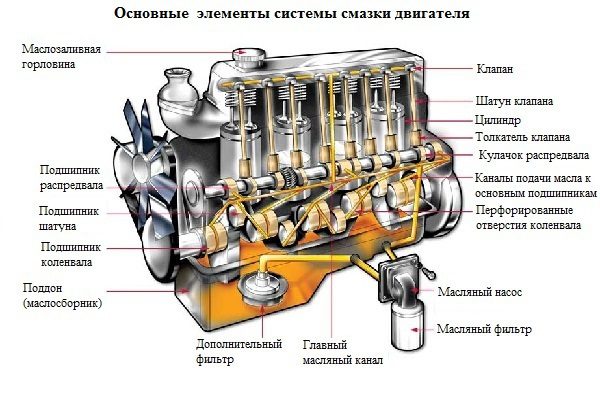
What are and how do sensors for the engine lubrication system work?
Content
For the correct operation of the engine lubrication system, a whole complex of sensors is used. They allow you to control the level (volume), pressure, quality (degree of contamination) and temperature of the engine oil. Modern vehicles use both mechanical and electrical (electronic) sensors. Their main task is to record any deviations in the state of the system from normal parameters and supply the corresponding information to the indicators of the car dashboard.
Purpose and device of the oil pressure sensor
Oil pressure sensors are among the most important in the system. They are among the first to react to the smallest malfunctions in the engine. Pressure sensors can be located in different places: near the cylinder head, near the timing belt, next to the oil pump, on the brackets to the filter, etc.
Different types of engines may have one or two oil pressure sensors.
The first one is emergency (low pressure), which determines whether there is pressure in the system, and if it is absent, it is signaled by turning on the malfunction indicator lamp on the car dashboard.
The second is the control, or absolute pressure.
If the “red oil can” on the dashboard of the car lights up - further movement on the car is prohibited! Ignoring this requirement can lead to serious troubles in the form of engine overhaul.
Note to motorists. Control lamps on the dashboard have different colors for a reason. Any red fault indicators prohibit further vehicle movement. Yellow indicators indicate that you need to contact the service in the near future.
The principle of operation of the emergency sensor
This is a mandatory sensor type for all vehicles. Structurally, it is very simple and consists of the following elements:
- the body;
- membrane;
- contacts;
- pusher.
The emergency sensor and indicator lamp are included in a common electrical circuit. When the engine is off and there is no pressure, the diaphragm is in a straight position, the circuit contacts are closed, and the pusher is fully retracted. At the moment the engine is started, voltage is applied to the electronic sensor, and the lamp on the dashboard lights up for a while until the desired oil pressure level is established in the system.
It acts on the membrane, which moves the pusher and opens the circuit contacts. When the pressure in the lubrication system drops, the diaphragm straightens again, and the circuit closes, turning on the indicator light.
How an absolute pressure sensor works
It is an analog device that displays the current pressure in the system using a pointer-type indicator. Structurally, a typical mechanical sensor for taking readings of oil pressure consists of:
- housing;
- membranes (diaphragms);
- pusher;
- slider;
- nichrome winding.
Absolute pressure transmitters can be rheostat or impulse. In the first case, its electrical part is actually a rheostat. When the engine is running, pressure arises in the lubrication system, which acts on the membrane and, as a result, the pusher changes the position of the slider located on the plate with a nichrome wire winding. This leads to a change in resistance and movement of the analog indicator needle.
Pulse sensors are equipped with a thermobimetallic plate, and their converter consists of two contacts: the upper one is a plate with a spiral connected to the indicator arrow, and the lower one. The latter is in contact with the sensor diaphragm and is shorted to ground (ground to the vehicle body). A current flows through the upper and lower contacts of the converter, heating its upper plate and provoking a change in the position of the arrow. The bimetallic plate in the sensor also deforms and opens the contacts until it cools. This ensures that the circuit is permanently closed and opened. Different pressure levels in the lubrication system have a definite effect on the bottom contact and change the opening time of the circuit (plate cooling). As a result, a different current value is supplied to the electronic control unit, and then to the pointer indicator, which determines the current pressure reading.
Oil level sensor, or electronic dipstick
Recently, more and more automakers are abandoning the use of the classic dipstick for checking the engine oil level in favor of electronic sensors.
The oil level sensor (sometimes also called an electronic dipstick) automatically monitors the level during vehicle operation and sends readings to the dashboard to the driver. Typically, it is located at the bottom of the engine, on a sump, or near the oil filter.
Structurally, oil level sensors are divided into the following types:
- Mechanical, or float. It consists of a float equipped with a permanent magnet and a vertically oriented tube with a reed switch. When the volume of oil changes, the float moves along the tube and when the minimum level is reached, the reed switch closes the circuit and supplies voltage to the corresponding indicator lamp on the dashboard.
- Thermal. At the heart of this device is a heat-sensitive wire, to which a small voltage is applied to warm up. After reaching the set temperature, the voltage is switched off and the wire is cooled down to the oil temperature. Depending on how much time passes, the volume of oil in the system is determined and the corresponding signal is given.
- Electrothermal. This type of sensor is a subtype of thermal. Its design also uses a wire that changes the resistance depending on the heating temperature. When such a wire is immersed in engine oil, its resistance decreases, which makes it possible to determine the volume of oil in the system by the value of the output voltage. If the oil level is low, the sensor sends a signal to the control unit, which compares it with the data on the lubricant temperature and signals the indicator to turn on.
- Ultrasonic. It is a source of ultrasonic pulses directed into the oil pan. Reflecting from the surface of the oil, such pulses are returned to the receiver. The transit time of the signal from the moment of sending to its return determines the amount of oil.
How is the oil temperature sensor
The engine oil temperature control sensor is an optional part of the lubrication system. Its main task is to measure the oil heating level and transmit the corresponding data to the dashboard indicator. The latter can be electronic (digital) or mechanical (switch).
At different temperatures, the oil changes its physical properties, which affects the operation of the engine and the readings of other sensors. For example, cold oil has less fluidity, which should be taken into account when obtaining oil level data. If the engine oil reaches temperatures above 130 ° C, it starts to burn, which can lead to a significant decrease in its quality.
Determining where the engine oil temperature sensor is located is not difficult - most often it is installed directly in the engine crankcase. In some car models, it is combined with an oil level sensor. The operation of the temperature sensor is based on the use of the properties of a semiconductor thermistor.
When heated, its resistance decreases, which changes the magnitude of the output voltage, which is supplied to the electronic control unit. Analyzing the received data, the ECU transmits information to the dashboard according to the preset settings (coefficients).
Features of the oil quality sensor
An engine oil quality sensor is also optional. However, since various contaminants (coolant, wear products, carbon deposits, etc.) inevitably get into the oil during operation of the engine, its actual service life decreases, and it is not always correct to follow the manufacturer's recommendations for replacement times.
The principle of operation of the sensor for monitoring the quality of engine oil is based on measuring the dielectric constant of the medium, which changes depending on the chemical composition. That is why it is positioned in such a way as to be partially submerged in oil. Most often, this area is located between the filter and the cylinder block.
Structurally, the sensor for oil quality control is a polymer substrate on which copper strips (electrodes) are applied. They are directed in pairs towards each other, forming a separate sensor in each pair. This allows you to get the most correct information. Half of the electrodes are immersed in oil, which has dielectric properties, making the plates work like a capacitor. On the opposite electrodes, a current is generated that flows to the amplifier. The latter, based on the magnitude of the current, supplies a certain voltage to the car's ECU, where it is compared with the reference value. Depending on the result obtained, the controller may issue a message about low oil quality to the dashboard.
Correct operation of the lubrication system sensors and monitoring of the oil condition ensures correct operation and an increase in the service life of the engine, but most importantly - the safety and comfort of vehicle operation. Like other parts, they require regular technical inspection, serviceability checks, and appropriate replacement when a breakdown is detected.
